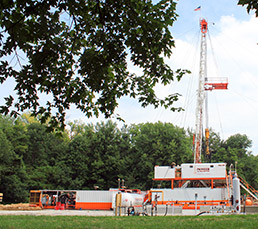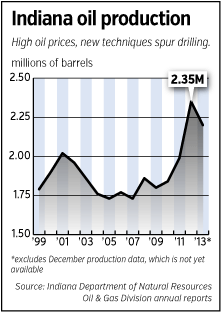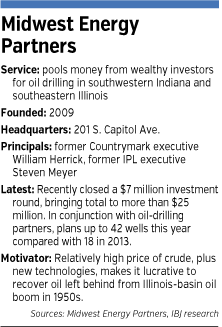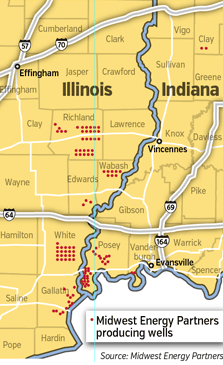Subscriber Benefit
As a subscriber you can listen to articles at work, in the car, or while you work out. Subscribe NowWhen December numbers are tallied, 2013 is likely to be the most bountiful year for bubbling crude in Indiana since the 2.43 million barrels of oil produced in 1997.
The 16-year high wouldn’t have happened if not for the usual players, such as Indianapolis-based Citizens Energy Group and the 80,000 barrels of oil it filled last year. And there’s refiner CountryMark, which manages 1,400 oil wells producing 3,500 barrels a day.
But the mini-boom in Indiana oil production is also being financed by private investors with heretofore little knowledge of the oil business—people like Steve Wade, director of business development at DeSeranno Wealth Planning, in Grosse Pointe Farms, Mich.
 Midwest Energy Partners has dozens of wells in Illinois and Indiana. (Photo courtesy of Midwest Energy Partners)
Midwest Energy Partners has dozens of wells in Illinois and Indiana. (Photo courtesy of Midwest Energy Partners)Wade and some business buddies have been quick studies and invested in dozens of wells through Indianapolis-based Midwest Energy Partners, formed four years ago by former CountryMark executive Bill Herrick.
“Immediately, you think ‘The Beverly Hillbillies,’ you know?” Wade said.
Collecting nearly $30 million for drilling projects since 2009, Midwest recently closed two more rounds that raised a total of $7 million.
The investment firm has ambitious plans for 42 wells this year compared with the 18 its operators drilled downstate and in southeastern Illinois in 2013. That would increase the firm’s owned production to more than 60,000 barrels.
 Many of these investors are getting in while the gettin’s good, with a barrel of U.S. crude averaging about $97 last year vs. $62 in 2009. Production economics have also improved, with newer drilling and high-tech exploration techniques.
Many of these investors are getting in while the gettin’s good, with a barrel of U.S. crude averaging about $97 last year vs. $62 in 2009. Production economics have also improved, with newer drilling and high-tech exploration techniques.
The biggest challenge, oddly enough, might be in getting anyone to believe the Midwest has the crude most commonly associated with the Southwest.
“A lot of people don’t realize there’s oil in Indiana. That’s the first shock factor they have to get over,” said Steven Meyer, executive vice president of Midwest and a former Indianapolis Power & Light executive.
Oil—in Indiana?
Fundraising for oil drilling doesn’t come naturally around these parts, especially when investors come from fields such as finance, accounting and medicine. (Herrick keeps his local investors’ names close to the vest.)
There simply aren’t pump jacks see-sawing away up this way as in Texas or Oklahoma.
But generations ago, Indiana was a big-time producer of oil.
Somebody found oil in Vigo County in the 1860s, piquing curiosity around the state. Soon they were drilling for oil under present-day Broad Ripple, where at least 70 wells were drilled until extracting more oil wasn’t practical.
 Then, in 1876, oil finds in Delaware County, northeast of Indianapolis, would lead to America’s first big oil and natural gas boom, known as the Trenton Field.
Then, in 1876, oil finds in Delaware County, northeast of Indianapolis, would lead to America’s first big oil and natural gas boom, known as the Trenton Field.
Poor well-management practices wasted the resources until the field became too depressurized to make it worthwhile to look for the crumbs.
As the Trenton Field faded, drilling picked up in southwestern Indiana and southern Illinois, in what’s known as the Illinois Basin. Geologically, the basin formed oil from 250 million years worth of trapped sediment and organic matter that once was a shallow sea.
Indiana oil production hit its peak in 1953, at 12.6 million barrels.
Nowadays, the Illinois Basin is the province of mostly small-time drillers who might spend $185,000 sinking a vertical well or $850,000 for a more complicated, horizontal well.
“The Illinois Basin has fallen off the map for big oil,” Herrick said.
 Meyer
MeyerThe fact that big oil left town and won’t be around to knock out smaller producers was appealing to Kurt Eckert, a principal of Wolverine Trading LLC in Chicago, who put some of his own money toward Midwest’s well projects.
He looks at oil as a way to diversify his investments, with the stock market gone up so much already and bond rates unattractive.
Historically, the stock market has doubled roughly every seven to 10 years, fellow investor Wade said.
“Can we do better than doubling our money in seven to 10 years? Well, yeah. We beat the market” in oil, he added.
“It’s a compelling story. They’ve got all this new drilling technology with the opportunity that hasn’t existed until recently,” Eckert said.
New techniques for old wells
 Herrick
HerrickMidwest has been careful about picking oil operators who are not only competent technically but also are willing to put some of their own money at risk to align their interests with investors', Herrick said. Among the three operators now working with Midwest are Illinois-based Pioneer Oil.
Operators may put up one-third the cost of a project to drill and manage wells. Midwest partners with three oil operators that drill and manage the holes. Operators plying the Illinois Basin have had to become smarter at the game, with oil increasingly challenging to find. Some now combine seismic mapping with satellite imagery to find lost pools. That’s paid off, with discoveries recently farther to the north in southern Illinois.
Much of the work, though, is going back to previously drilled areas’ untapped opportunities. Often, the old-timers drilled to a depth of, say, 1,200 to 2,000 feet. Once they hit oil, they moved on. Nowadays, Midwest’s operators may sink the well as deep as 5,000 feet to find oil that was missed.
They’ll drill in flood-prone river bottoms that used to spook old-timers—or sometimes on islands that are hard to access.
They’re also using horizontal drilling techniques that extend laterally from a single hole. Injecting liquids is another technique to flush out trapped oil.
“It seems to be a low-risk proposition because we know the oil is down there,” Meyer said.
He’s not kidding—the firm didn’t have a single “dry hole” last year, a term referring to wells that don’t produce commercially viable amounts of oil.
 “Knock on wood,” Meyer said, literally knocking on a table.
“Knock on wood,” Meyer said, literally knocking on a table.
Accredited investors only
Getting in on this rather exotic form of investing isn’t for mom-and-pop investors.
While Midwest has lowered its minimum investment to $50,000, from $250,000 in the early days, investors must meet minimum net worth/net income standards. For individuals, that’s a minimum net worth of $1 million or annual net income of $200,000 or more.
Corporations and partnerships must have a net worth of $5 million or greater. Such accreditation requirements arose partly from oil-and-gas investing schemes over the years.
Herrick is mindful of the bad reputation for such investments. His team prepares monthly reports for investors that include receipts for how much money was spent for drilling expenses. He’ll point out some little-known tax deductions for oil investors, as well.
His firm also divides investors’ money up among several different clusters of wells and claims, in effect diversifying one’s investment much like buying several individual fund families within a mutual fund.
“It’s not like you’re stuck on one lease,” Eckert said.
There are tours of well sites, as well.
“Most of these have never invested in oil before. It’s a totally new concept for them,” Herrick said.
He and Meyer will hit the highway or hop on an investor’s airplane to visit a well site in parts unknown, downstate.
“You can actually see it and you can actually touch it,” Wade said of the drilling rig.
Ramping up for more
The firm intends to raise $5 million to $10 million more this year. One investor suggested the company conduct an initial public stock offering. But having worked for public companies in the past, Meyer says no way. “We’ve lived that life before.”
But with opportunities popping up every so often to secure a promising tract of land for long-term production, the executives have been looking at the potential to tap a private capital firm to put together a credit facility that would fund investments over a longer term. That would be a quick source of cash if one of Midwest’s operators wanted to make a large acquisition to help develop a promising field.
As for looking outside Indiana and Illinois for oil—such as in the southern part of the Illinois Basin in Kentucky, that’s probably not practical. Setting up at a site can involve an entourage of 20 semi trucks to haul equipment, so far-flung locations can be costly. Finding someone dependable enough to monitor daily well flows in a remote area is another challenge.
Midwest has also kicked around the idea of drilling for natural gas. The challenge there is that Indiana lacks pipeline infrastructure to move the gas from well sites.
As for continued production in Indiana, that largely depends on how much money producers can fetch for a barrel of oil, said Jim AmRhein, assistant director of the Indiana Department of Natural Resources’ Oil & Gas Division.
The higher the price, the more incentive there is to find it. It’s why drilling is under way even under Indiana State University’s campus, in Terre Haute.
If oil prices hold up, “I look for [production] to stay relatively flat,” AmRhein said.
For an oil field beyond its peak years, that’s a big deal.•
Please enable JavaScript to view this content.
